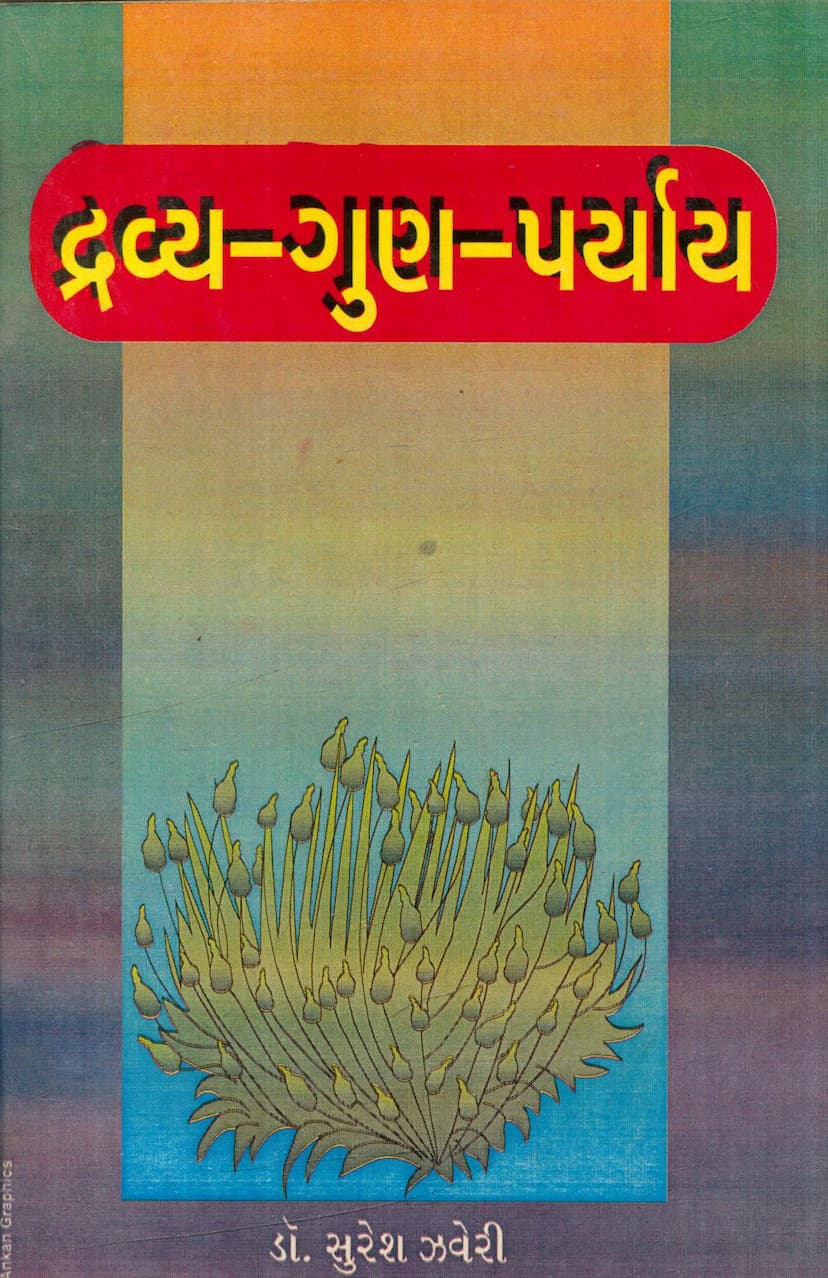Dravya Gun Paryay
Added to library: September 1, 2025

Summary
This comprehensive summary is based on the provided text, focusing on the core concepts of Dravya, Guna, and Paryay within Jain philosophy as presented in "Dravya Gun Paryay" by Dr. Suresh Zaveri.
Book Title: Dravya Gun Paryay Author: Dr. Suresh Zaveri Publisher: Navdarshan Public Charitable Trust
Overall Theme: The book "Dravya Gun Paryay" delves into the fundamental Jain philosophical concepts of Dravya (Substance), Guna (Attribute), and Paryay (Modification/State) to explain the nature of the soul (Atma) and the path to liberation (Moksha). The author emphasizes the importance of understanding these principles to move from outward (bahirmukhta) to inward focus (antarmukhta) and to achieve self-realization.
Key Concepts Explained:
-
Dravya (Substance):
- Dravya is the fundamental reality, the eternal, unchanging essence of a thing. It is the substratum that persists through time and change.
- In Jainism, Dravya is understood as the five Astikayas (Jiva, Ajiva, Dharma, Adharma, Akasha) and Kala (Time).
- Dravya is characterized by its eternal existence, non-creation, and non-destruction. It is the "whole" or the "absolute."
- The soul (Atma) is a pure, conscious, and blissful Dravya, inherently existing and unchanging in its true nature.
- The book stresses that all six Dravyas are independent and do not affect each other in their fundamental nature, although indirect interaction (nimitta-naimittik sambandh) occurs.
-
Guna (Attribute):
- Gunas are the inherent, eternal, and essential attributes or qualities of a Dravya. They are inseparable from the Dravya and define its nature.
- For the soul (Jiva Dravya), the core Gunas are infinite knowledge (Jnana), infinite perception (Darshan), infinite bliss (Sukha), infinite power (Virya), and others like consciousness (Chaitanya), existence (Astitva), and formlessness (Aroop).
- Gunas are described as the "part" that is intrinsically connected to the "whole" (Dravya). They are not separate entities but inherent characteristics of the substance.
- The book emphasizes that Gunas are also eternal and unchanging in their essence, even though their manifestation (Paryay) may change.
-
Paryay (Modification/State):
- Paryays are the momentary, transient states or modifications of a Dravya that occur due to the interaction of Gunas. They are the changing aspects of a substance.
- Paryays are characterized by origination (Utpad), cessation (Vyay), and the underlying permanence of the Dravya (Dhruva). This is summarized as "Utpad-Vyay-Dhruva Yukta Sat" (Existence characterized by origination, cessation, and permanence).
- For the soul, Paryays include states like knowledge, ignorance, attachment, aversion, happiness, sorrow, birth, death, and the states of liberation.
- The book strongly warns against "Paryay Mudhta" (delusion of Paryay), which is the mistake of identifying oneself with these transient states rather than the eternal Dravya. This attachment to Paryays leads to the cycle of birth and death.
- It explains that while Paryays are transient and changing, they are still considered "real" (Sat) in their momentary existence and are dependent on the Dravya for their manifestation.
Key Arguments and Teachings:
-
Nishchaya Naya (Ultimate Truth) vs. Vyavahar Naya (Conventional Truth): The book extensively discusses the interplay between Nishchaya Naya and Vyavahar Naya.
- Nishchaya Naya emphasizes the ultimate reality of the soul as pure, unchanging Dravya and its inherent Gunas. This is the path of self-realization and liberation.
- Vyavahar Naya explains the practical, everyday world and the apparent changes (Paryays) that occur. While Paryays are not the ultimate truth, understanding them correctly is necessary to navigate the path.
- The author advocates for prioritizing Nishchaya Naya for spiritual progress while acknowledging the role of Vyavahar Naya.
-
The Soul's True Nature: The soul is described as pure consciousness, knowledge, bliss, and power. Its true nature is unaffected by external substances or internal passions like attachment and aversion.
-
The Illusion of Identification with Paryays: The central problem highlighted is the soul's mistaken identification with its transient states (Paryays) like emotions, body, and karmic influences. This "Paryay Buddhi" (identification with Paryay) keeps the soul bound to the cycle of suffering.
-
The Path to Liberation:
- Discernment: The first step is to discern between the eternal Dravya/Guna and the transient Paryay.
- Detachment from Paryays: Through right knowledge, one must develop detachment from all Paryays, including both auspicious (shubh) and inauspicious (ashubh) states, as they are ultimately transient.
- Focus on Dravya: The ultimate goal is to fix one's consciousness and attention on the true, pure, unchanging nature of the soul (Dravya). This inward focus leads to the manifestation of the soul's inherent pure qualities.
- Right Faith, Knowledge, and Conduct: The book implicitly or explicitly supports the Jain path of Samyak Darshan (Right Faith), Samyak Jnana (Right Knowledge), and Samyak Charitra (Right Conduct) as the means to achieve liberation.
-
Metaphors and Examples: The book uses analogies like the ocean and waves, the sky and clouds, and the clay pot to illustrate the relationship between Dravya, Guna, and Paryay.
-
Importance of Guru and Scriptures: The text emphasizes the guidance of learned spiritual teachers (Sadgurus) and the study of scriptures as crucial for understanding these subtle philosophical concepts correctly.
Structure of the Book (Based on Table of Contents):
The book appears to cover the topic from various angles, including:
- Introduction (Upo'dghat)
- Dravya-Guna-Paryay from Agama (scriptural) style.
- Dravya-Guna-Paryay from Adhyatma (spiritual/experiential) style.
- A "Ras" (poetic composition) on Dravya-Guna-Paryay.
- Discussion on delusion related to Paryays and identification with them.
- Question and Answer section.
- Conclusion (Upsanhar).
In essence, "Dravya Gun Paryay" is a guide to understanding the eternal, unchanging essence of the soul (Dravya) and its inherent qualities (Gunas), distinct from its temporary states (Paryays). By shifting focus from the transient to the eternal, individuals can break free from the cycle of karma and attain liberation, as taught in Jainism.